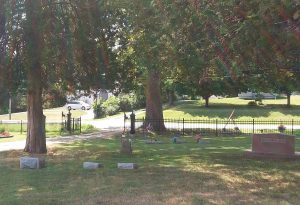Family’s care for Olio Township Cemetery passes through generations
By Holly Eitenmiller For Chronicle Media — August 17, 2018
All that remains of the former Olio Township Cemetery fence are the Main Street entrance gates, which, when closed, no longer meet at the center. The first fence, constructed in 1906 by Stewart Iron of Cincinnati, Ohio, was built to allow horse-drawn carriages onto the grounds, not automobiles. (Photo by Holly Eitenmiller / for Chronicle Media)
Olio Cemetery was a special place to Rosemary Hartter, so much so that when she passed away in February, her final wish was to see the historical graveyard fitted with a new iron fence.
On July 3, the fence surrounding Hartter’s final resting place was completed, in part due to her financial contributions to the project while living, and donations made in her honor following her death.
“It was her wish that, upon her death, memorials be made to the fence fund,” Hartter’s daughter Jan Holliger said. “Over $5,000 was given and in her will she also left a considerable amount of money to the cemetery.”
Holliger, who took over as superintendent of the Eureka cemetery after her mother’s 2017 resignation, pitched in some of her own money, and, after Hohulin Fence Company lowered its bid a bit to help, the project was complete.
“It mattered so much to my mother and now it’s done,” Holliger said. “The fence company took the old fence, and it was sold to different pieces, so some pieces will come back to Eureka.”
Only the entrance gate remains of the former fences, which was installed in 1906 by Stewart Iron Works of Cincinnati, Ohio. Olio Township requisitioned the fence after it garnered the cemetery from the City of Eureka in 1905.
In the years that followed, weather, road salt, car accidents and other environmental factors took a toll on the old fence. In the 1970s, the township began replacing portions of the fence on an as-needed basis, while the rest of it continued to degrade and fall apart.
“What Hohulin did with the fence was up to them to take care of and take away,” Holliger said. “We really didn’t have the time or space to take care of it or let it pile up.”
In 2011, the Olio Cemetery board, consisting of Hartter, Leroy Thomas and Ken Jackson, began securing bids for the replacement fence. The western portion was replaced first with money willed to the cemetery by the late Helen Bone Major.
Later, the original posts and gates were set at the west cemetery entrance on Main Street, and the final work was completed almost seven years after the project began.
“My mom was a wonderful lady, and the cemetery was very important to her,” Holliger said. “She took care of this on her own. She also did commodity marketing, drove a school bus, was a tailor. We were taking care of this place by ourselves until she got sick.”
Hartter’s husband Calvin served as cemetery superintendent until his death from cancer in 1963, and she was appointed his successor and remained superintendent until her September 2017 resignation.
Holliger began as caretaker for the cemetery in the early 1970s and in that time, she has dug graves, both by shovel and with the help of the equipment.
With the help of caretaker Bill Burton, the cemetery is kept free of weeds, nicely mowed and frequently updated.
“I buried him. I also buried that person,” she says, pointing to different markers dating past 1970. “These are special people here, members of the community, and there are some really interesting stories in this cemetery.”
Near the west entrance lies Robert Moody, an African-American man who, in the mid-1800s proved himself a free man and purchased his father and fiancé at auction to free them from slavery.
Samuel Ellis Adams, a WWII B-24 gunner whose remains were found 17 years after his disappearance, is interred in the northwest section of the cemetery. Nobel Prize winner Dr. Stephen B. Binkley rests in the same area with Dr. Richard Jackson, who garnered the Distinguished Service Medal for research on the production of antibiotics.
Holliger detailed much of the cemetery’s past in “A Walk Through History”, a 14-page document that breaks the 20-acre cemetery into sections, and tells tales of events that happened and people who are buried there.
“We have very good records of the early burials and a lot of interesting things about the cemetery,” she said. “We have one Revolutionary War hero, and all the wars are represented here.”
Olio Cemetery first began as a burial place for the Walnut Grove Christian Church on property donated by Ben Major. The first burial was that of Abram Tressler, who, along with his brother, Johnathon, helped build the church in 1846.
When the church was moved in 1864, an agreement was formed with local officials for the city to assume responsibility of the cemetery. Forty years later, it was handed over to Olio Township, which also purchased an additional 7.24 acres of land from Fred J. Smith at $3,200.
“Abram Tressler is buried near where the church stood, and they have the soldier’s monument there, which was put up in 1868,” Holliger said. The soldier’s monument was recently updated and is the site of the city’s annual Memorial Day service.
“There’s always a parade every year, and Memorial Day is a very important day in Eureka,” she said. “I keep track of all the records for the burials for the Legion, and they now put out the flags for Memorial Day.”
Some of the flags are casket flags, which are kept under the auspices of the cemetery, along with the flagpoles from which they are displayed for the annual Avenue of Flags.
“There’s a lot of work here, all year ‘round, and there’s days, like any job, when you want to throw in the towel,” Holliger admitted. “I love it, though, and I love to be outside. You meet a lot of wonderful people, and their families are buried here. My mother is buried here.”
Hartter is buried alongside her husband, within the boundaries of the new iron fence she worked diligently to replace.
The original gates on Main Street do not close; they don’t meet in the middle. They were, Holliger said, forged before the advent of the automobile and were meant for the passage of horse-drawn carriages.
— Family’s care for Olio Township Cemetery continues on —







